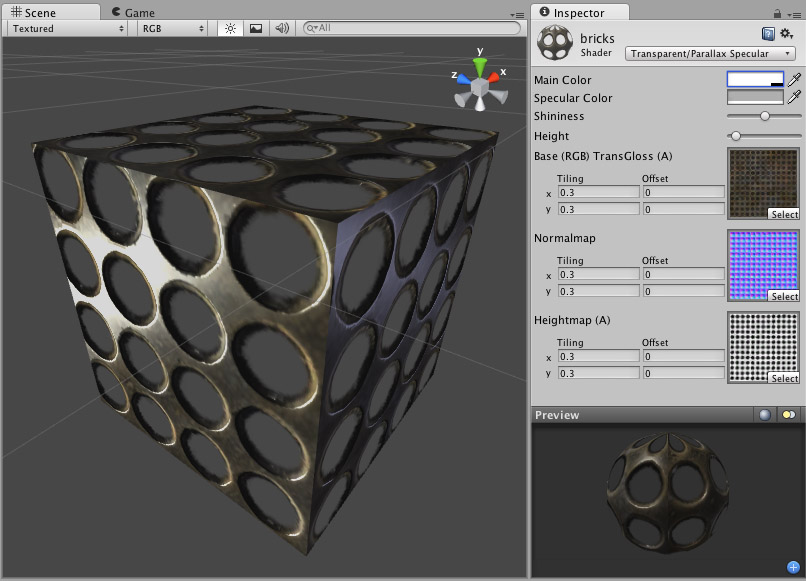Transparent Parallax Specular
Note. Unity 5 introduced the Standard Shader which replaces this shaderA program that runs on the GPU. Standard Shader which replaces this shaderA program that runs on the GPU. More info
See in Glossary.

One consideration for this shader is that the Base texture’s alpha channel defines both the Transparent areas as well as the Specular Map.
Transparent Properties
Note. Unity 5 introduced the Standard Shader which replaces this shader.
This shader can make meshThe main graphics primitive of Unity. Meshes make up a large part of your 3D worlds. Unity supports triangulated or Quadrangulated polygon meshes. Nurbs, Nurms, Subdiv surfaces must be converted to polygons. More info
See in Glossary geometry partially or fully transparent by reading the alpha channel of the main texture. In the alpha, 0 (black) is completely transparent while 255 (white) is completely opaque. If your main texture does not have an alpha channel, the object will appear completely opaque.
Using transparent objects in your game can be tricky, as there are traditional graphical programming problems that can present sorting issues in your game. For example, if you see odd results when looking through two windows at once, you’re experiencing the classical problem with using transparency. The general rule is to be aware that there are some cases in which one transparent object may be drawn in front of another in an unusual way, especially if the objects are intersecting, enclose each other or are of very different sizes. For this reason, you should use transparent objects if you need them, and try not to let them become excessive. You should also make your designer(s) aware that such sorting problems can occur, and have them prepare to change some design to work around these issues.
TransFamilyImport
Parallax Normal mapped Properties
Parallax Normal mapped is the same as regular Normal mapped, but with a better simulation of “depth”. The extra depth effect is achieved through the use of a Height Map. The Height Map is contained in the alpha channel of the Normal mapA type of Bump Map texture that allows you to add surface detail such as bumps, grooves, and scratches to a model which catch the light as if they are represented by real geometry.
See in Glossary. In the alpha, black is zero depth and white is full depth. This is most often used in bricks/stones to better display the cracks between them.
The Parallax mapping technique is pretty simple, so it can have artifacts and unusual effects. Specifically, very steep height transitions in the Height Map should be avoided. Adjusting the Height value in the InspectorA Unity window that displays information about the currently selected GameObject, asset or project settings, allowing you to inspect and edit the values. More info
See in Glossary can also cause the object to become distorted in an odd, unrealistic way. For this reason, it is recommended that you use gradual Height Map transitions or keep the Height slider toward the shallow end.
ParallaxSubsetImport
Specular Properties
Specular computes the same simple (Lambertian) lighting as Diffuse, plus a viewer dependent specular highlight. This is called the Blinn-Phong lighting model. It has a specular highlight that is dependent on surface angle, light angle, and viewing angle. The highlight is actually just a realtime-suitable way to simulate blurred reflection of the light source. The level of blur for the highlight is controlled with the Shininess slider in the Inspector.
Additionally, the alpha channel of the main texture acts as a Specular Map (sometimes called “gloss map”), defining which areas of the object are more reflective than others. Black areas of the alpha will be zero specular reflection, while white areas will be full specular reflection. This is very useful when you want different areas of your object to reflect different levels of specularity. For example, something like rusty metal would use low specularity, while polished metal would use high specularity. Lipstick has higher specularity than skin, and skin has higher specularity than cotton clothes. A well-made Specular Map can make a huge difference in impressing the player.
SpecularSubsetImport
Performance
Generally, this shader is on the more expensive rendering side. For more details, please view the Shader Peformance page.
TransParallaxSpecular